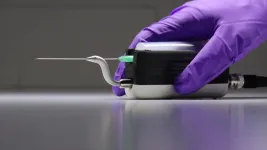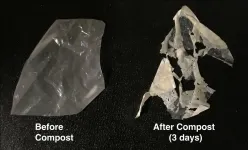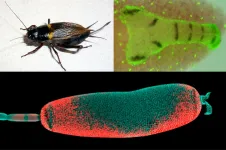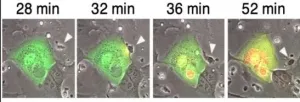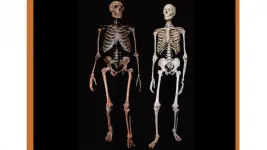(Press-News.org) The diagnosis of diseases like cancer almost always needs a biopsy - a procedure where a clinician removes a piece of suspect tissue from the body to examine it, typically under a microscope. Many areas of diagnostic medicine, especially cancer management, have seen huge advances in technology, with genetic sequencing, molecular biology and artificial intelligence all rapidly increasing doctors' ability to work out what's wrong with a patient. However the technology of medical needles hasn't changed dramatically in 150 years, and - in the context of cancer management - needles are struggling to provide adequate tissue samples for new diagnostic techniques. Now researchers have shown that modifying the biopsy needle to vibrate rapidly at 30,000 times per second not only provides sufficient data for 21st century diagnostic needs, but is also potentially less painful and less traumatic for patients.
"Biopsy yields - the amount of tissue extracted - are often inadequate, with some studies showing that up to a third of fine-needle biopsies struggle to get enough tissue for a reliable diagnosis," says Professor Heikki Nieminen, at Aalto University, Department of Neuroscience and Biomedical Engineering. "A biopsy can be painful, and the wait for the results from a diagnostic test can be a highly distressing time for the patient and family, especially if diagnosis needs re-biopsies to be conclusive. We wanted to make the procedure more gentle for the patient, and increase the certainty that the test will be able to give us an answer on the first attempt." Professor Nieminen was visiting the University of Toronto, Canada, to work with Professor Kenneth Pritzker, a Pathologist at Mount Sinai Hospital, Toronto, as well as a university researcher in the Temerty Faculty of Medicine. It was while they were at lunch one day that Pritzker suggested that maybe the solution to the problem could be addressed with the help of ultrasound.
One of the least painful biopsy methods is called 'fine-needle biopsy', which uses a needle the same thickness as in many other medical procedures. However for more advanced diagnostic treatments - like those used in cancer - fine-needles alone don't get enough material routinely enough, so the current practice is often to use a much thicker needle, called a core needle. "They are painful for the patient and can also cause bleeding - you don't want to use a core needle unless you have to." says Pritzker. "At body temperature, human tissue exists as something that behaves part-way between being a solid and a liquid. The breakthrough here is that by making the needle tip vibrate ultrasonically, we're able to make the tissue flow more like a liquid, which allows us to extract more of it through a narrow needle."
Feels like a regular needle
In a new paper, published in Scientific Reports, the team is sharing with the wider world how well these ultrasonic vibrating needles work. "The vibrations provide energy to the tissue to make it more fluid-like," explains the first author of the paper, Emanuele Perra, who works in Nieminen's group at Aalto University. "The vibrations are localised to just the tip, so it doesn't affect any other tissue except a small region around the needle. We were able to show that the ultrasonic vibrations increase the biopsy yield by 3 to 6 times compared to the same needle without ultrasound, which was even greater than we hoped for." The vibrations are far above the hearing range for humans, and the amplitude of the waves is small enough that it shouldn't feel much different to a normal blood test.
The big increase in the amount of tissue extracted in the biopsy means it is very useful for the growing trend for high-tech cancer treatment. One such example is molecular diagnostics, which examine the chemical makeup of tumours, to allow doctors to target treatment more effectively to a specific cancer type. "Molecular diagnostics is an expensive process, and it is an expensive waste of money to have it fail because the quality of the material gathered in the biopsy wasn't previously good enough," explains Pritzker.
The technology that powers the needle is non-linear acoustics, where vibrations passing through a material have such large amplitude that they interact with the material itself. These interactions allowed the needle's designers to focus all the energy to just the tip of the needle, and measure their effects. "We've been able to characterise the vibrations at the end of the needle really well. We've used high speed cameras that have allowed us to study the physical effects of the vibrating needle on boundaries between fluids, solids and air in unprecedented detail," says Nieminen. "The rich understanding we've managed to get of the physics allowed us to design the medical device and understand how it could be used for different medical purposes."
Medical trials getting underway
The needle is expected soon to move into studies with real cancer patients, although for the time being only four-legged ones. A specialist veterinary hospital in Canada is soon expected to be trialing the device on domestic pets with cancer, and if all goes as expected, the team hopes that their needles will be used in human patients soon after.
"Modern oncology doesn't just take a biopsy at the beginning of treatment", explains Nieminen. "Increasingly, oncologists want to be able to take multiple biopsies to track how the tumors are changing and responding over the course of the treatment. We want the tools for these biopsies to be as effective and painless as possible."
While the team is preparing the needles for the real world biopsies, they are also excited about future applications that they are still researching. "The effect that ultrasonic vibrations have on tissue might also be able to work the other way" explains Perra, "the vibrations might make it easier to deliver pharmaceuticals in a targeted way to tissue like the liver. They might also be able to break up small hard objects in soft tissue, like kidney stones, or even small tumours - all minimally invasively." By combining experts in acoustics physics with experts in medical technology, the team hopes that many more innovations will arise from their 21st century upgrade of the humble medical needle.
INFORMATION:
The paper Ultrasonic Actuation of a Fine-Needle Improves Biopsy Yield, is published in Scientific Reports DOI: https://doi.org/10.1038/s41598-021-87303-x The work was funded by the Academy of Finland. Professors Nieminen and Pritzker are shareholders in Swan Cytologics Inc., Toronto, Canada, which aims to commercialise the technology and hold pending patents for it.
Contact details
Heikki Nieminen
Professor
Aalto University
Email: heikki.j.nieminen@aalto.fi
tel:+358505019280
Kenneth Pritzker
Professor Emeritus
University of Toronto, Mount Sinai Hospital Toronto
Email: k.pritzker@utoronto.ca
Emanuele Perra
Doctoral researcher
Aalto University
Email: emanuele.perra@aalto.fi
More multimedia
Watch biopsy needle comparison video: https://www.youtube.com/watch?v=0ZAesqqUjNc
Creating micro-droplets with ultrasound-enhanced medical needle https://youtu.be/zxZeYT_n8Zo
Transport of micro-particles with ultrasound-enhanced medical needle. https://youtu.be/z3Ktza6qCLs
Acoustic cavitation with ultrasound-enhanced medical needle : https://youtu.be/yf1eafMK87c
PHILADELPHIA--Piperlongumine, a chemical compound found in the Indian Long Pepper plant (Piper longum), is known to kill cancerous cells in many tumor types, including brain tumors. Now an international team including researchers from the Perelman School of Medicine at the University of Pennsylvania has illuminated one way in which the piperlongumine works in animal models -- and has confirmed its strong activity against glioblastoma, one of the least treatable types of brain cancer.
The researchers, whose findings were published this month in END ...
Scientists have spotted the largest flare ever recorded from the sun's nearest neighbor, the star Proxima Centauri.
The research, which appears today in The Astrophysical Journal Letters, was led by the University of Colorado Boulder and could help to shape the hunt for life beyond Earth's solar system.
CU Boulder astrophysicist Meredith MacGregor explained that Proxima Centauri is a small but mighty star. It sits just four light-years or more than 20 trillion miles from our own sun and hosts at least two planets, one of which may look something like ...
RESEARCH TRIANGLE PARK, N.C. -- With Army funding, scientists invented a way to make compostable plastics break down within a few weeks with just heat and water. This advance will potentially solve waste management challenges at forward operating bases and offer additional technological advances for American Soldiers.
The new process, developed by researchers at University of California, Berkeley and the University of Massachusetts Amherst, involves embedding polyester-eating enzymes in the plastic as it's made.
When exposed to heat and water, an enzyme shrugs off its polymer shroud and starts chomping the plastic polymer into its building blocks -- in the case of biodegradable plastics, which are made primarily of the polyester known as polylactic acid, or PLA, ...
Women at high risk of breast cancer face cost-associated barriers to care even when they have health insurance, a new study has found.
The findings suggest the need for more transparency in pricing of health care and policies to eliminate financial obstacles to catching cancer early.
The study led by researchers at The Ohio State University included in-depth interviews with 50 women - 30 white, 20 Black - deemed at high risk of breast cancer based on family history and other factors. It appears in the Journal of Genetic Counseling.
The researchers considered it a given that women without any insurance would face serious barriers to preventive care including genetic counseling and testing, prophylactic mastectomy and ...
OAK BROOK, Ill. - An artificial intelligence-driven system that automatically combs through brain MRIs for abnormalities could speed care to those who need it most, according to a study published in Radiology: Artificial Intelligence.
MRI produces detailed images of the brain that help radiologists diagnose various diseases and damage from events like a stroke or head injury. Its increasing use has led to an image overload that presents an urgent need for improved radiologic workflow. Automatic identification of abnormal findings in medical images offers a potential solution, enabling improved patient care and accelerated patient discharge.
"There are an increasing number of MRIs that are performed, ...
Certain signalling proteins, which are responsible for the development of innate immune function in almost all animals are also required for the formation of the dorsal-ventral (back-belly) axis in insect embryos. A new study by researchers from the University of Cologne's Institute of Zoology suggests that the relevance of these signalling proteins for insect axis formation has increased independently several times during evolution. For example, the research team found similar evolutionary patterns in the Mediterranean field cricket as in the fruit fly Drosophila, although the two insects are only very distantly related and previous observations suggested different evolutionary ...
Metaplasia is defined as the replacement of a fully differentiated cell type by another. There are several classical examples of metaplasia, one of the most frequent is called Barrett's oesophagus. Barrett's oesophagus is characterized by the replacement of the keratinocytes by columnar cells in the lower oesophagus upon chronic acid reflux. This metaplasia is considered a precancerous lesion that increases by around 50 times the risk of this oesophageal adenocarcinoma. Nonetheless, the mechanisms involved in the development of metaplasia in the oesophagus are still partially unknown.
In a new study published in Cell Stem Cell, researchers led by Mr. Benjamin Beck, ...
Drawing on epidemiological field studies and the FrenchCOVID hospital cohort coordinated by Inserm, teams from the Institut Pasteur, the CNRS and the Vaccine Research Institute (VRI, Inserm/University Paris-Est Créteil) studied the antibodies induced in individuals with asymptomatic or symptomatic SARS-CoV-2 infection. The scientists demonstrated that infection induces polyfunctional antibodies. Beyond neutralization, these antibodies can activate NK (natural killer) cells or the complement system, leading to the destruction of infected cells. Antibody levels are slightly lower in asymptomatic ...
Creativity--the "secret weapon" of Homo sapiens--constituted a major advantage over Neanderthals and played an important role in the survival of the human species. This is the finding of an international team of scientists, led by the University of Granada (UGR), which has identified for the first time a series of 267 genes linked to creativity that differentiate Homo sapiens from Neanderthals.
This important scientific finding, published today in the prestigious journal Molecular Psychiatry (Nature), suggests that it was these genetic differences linked to creativity that enabled Homo sapiens to eventually replace Neanderthals. It was creativity that gave Homo sapiens the ...
Children with weakened immune systems have not shown a higher risk of developing severe COVID-19 infection despite commonly displaying symptoms, a new study suggests.
During a 16-week period which covered the first wave of the pandemic, researchers from Southampton carried out an observational study of nearly 1500 immunocompromised children - defined as requiring annual influenza vaccinations due to underlying conditions or medication. The children, their parents or guardians completed weekly questionnaires to provide information about any symptoms they had experienced, COVID-19 test results and the impact of the pandemic on their daily life.
The results, published in BMJ Open, showed that symptoms of COVID-19 infection were common in many of the children - with ...
